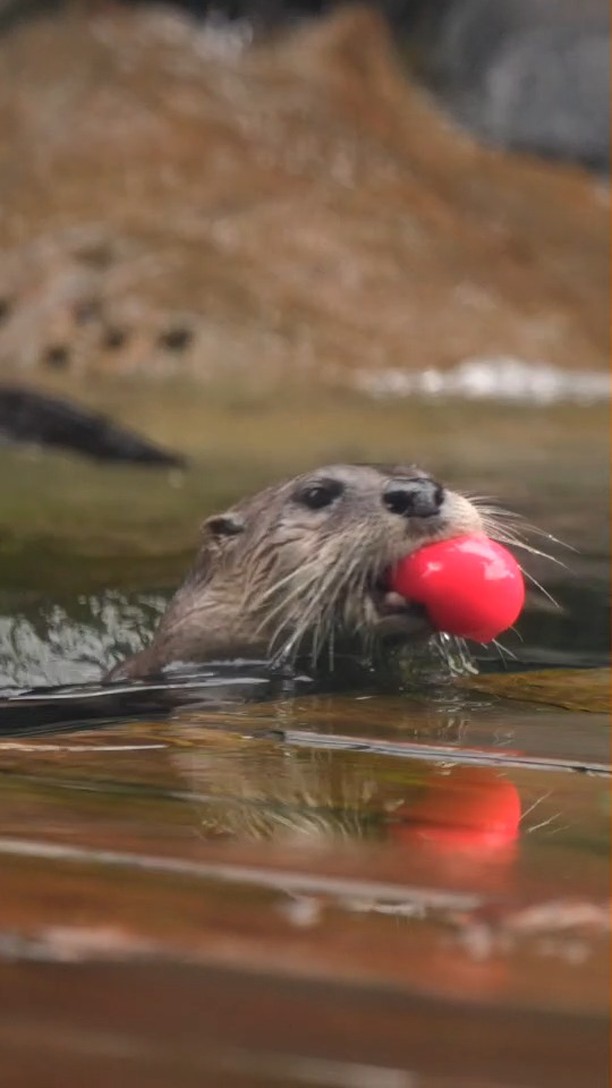– River otter behavior and ecology related to play and foraging
– The design and benefits of enrichment activities like egg hunts in zoos and sanctuaries
– Short- and long-term impacts of enrichment on animal welfare in captivity
– The role of public engagement and educational programs in wildlife conservation
– Ethical considerations and challenges in wildlife management and zoo operations
River otters are fascinating and charismatic creatures known for their playful antics and exceptional swimming abilities. Belonging to the Mustelidae family, which includes weasels, badgers, and minks, these agile mammals are found near water bodies across various parts of North America. They are well-adapted to life in and around the water, with streamlined bodies, webbed feet, and thick, water-repellent fur. River otters exhibit complex social structures and playful behaviors, including sliding down riverbanks and engaging in games that mirror hunting practices. Their play is not just a source of amusement; it also helps them learn essential survival skills.
Enrichment is crucial in ensuring the physical and psychological wellbeing of animals in zoos and wildlife sanctuaries, including river otters. Enrichment comes in many forms, from introducing new scents or puzzles to simulated foraging activities like egg hunts. Activities that simulate natural behaviors can promote exercise, mental stimulation, and the expression of innate behaviors. Watching river otters search for, play with, and savor their colorful, hard-boiled treats is delightful for zoo visitors and serves a critical purpose in maintaining their overall health and happiness.
Introducing varied enrichment activities such as egg hunts encourages the natural foraging instincts of river otters. These behaviorally enriching activities can stimulate problem-solving skills and encourage physical activity that reflects natural otter behavior. They have an inherent propensity to explore and manipulate their environment, and providing them with opportunities to do so can reduce stress, prevent boredom, and discourage negative behaviors that may stem from a lack of stimulation. These activities can enhance an otter’s cognitive functions and contribute to a more dynamic and fulfilling life in captivity.
As a tool for education and conservation, such public displays can captivate audiences and draw attention to the needs and behaviors of wildlife. Engaging educational programs that include enrichment demonstrations allow zoo visitors to learn about otter ecology and conservation issues. These programs have the potential to instill environmental stewardship in the public and generate support for conservation initiatives. Demonstrating how otters naturally behave and adapt to challenges encourages an appreciation for them and sends a message on the importance of preserving their natural habitats.
However, using enrichment in zoo management comes with its own ethical considerations and practical challenges. While providing enrichment is intended to improve animal welfare, zookeepers and wildlife managers must continuously evaluate and adapt these activities to suit each animal’s individual needs. Like any aspect of zoo management, enrichment must be undertaken carefully, based on sound behavioral science and species-specific knowledge. Ensuring the welfare of captive animals requires a holistic approach that considers their dietary needs, social structures, natural behaviors, and psychological health. The design and implementation of enrichment activities must be informed by current research and regularly reviewed to accommodate the changing needs of the animals as they age or as their environment changes.
Moreover, managing wildlife in zoos is a complex responsibility that involves ethical dilemmas and practical issues ranging from habitat design to nutrition and healthcare. It demands a delicate balance between providing safe and comfortable living conditions and allowing animals to behave naturally. The debate over the role of zoos in conservation and animal welfare is ongoing. Still, thoughtful enrichment programs signify a commitment to applying the highest standards of care and providing a simulacrum of wild conditions within the inevitable constraints of captivity.
Through enrichment initiatives like river otter egg hunts, zoos can foster a deeper understanding among visitors of the importance of biodiversity and the interconnections between species and their environments. Watching river otters engage with their environment captivates audiences and is a powerful educational tool. It provides a tangible link between the joy of experiencing wildlife and the imperative to engage in conservation practices that protect these vibrant creatures and their habitats for future generations.
In summary, river otters are a testament to the intelligence and adaptability of mammalian life, and their care in zoos reflects broader themes in animal welfare and environmental education. Enrichment activities like egg hunts play a significant role in maintaining the wellbeing of these animals and offer avenues for engaging the public in wildlife conservation. As we strive to protect and understand these remarkable animals, we continue to learn valuable lessons about the intricate tapestry of life that sustains our planet and our responsibility to preserve it.
*****
Source Description
More egg hunts? Yes, please! Watch our river otters search for, play with and feast on their colorful, hard-boiled treats. 🦦🦦


